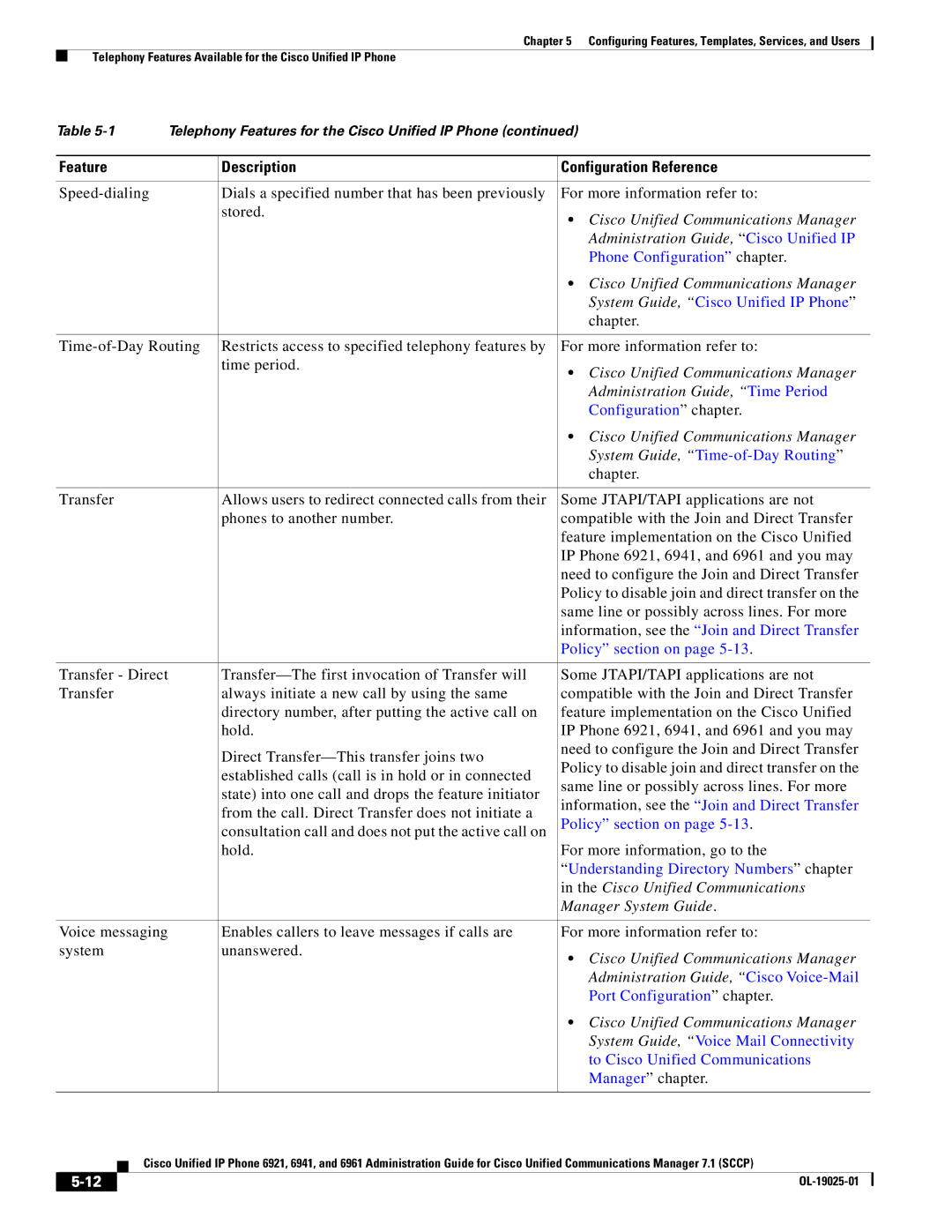
Chapter 5 Configuring Features, Templates, Services, and Users
Telephony Features Available for the Cisco Unified IP Phone
Table | Telephony Features for the Cisco Unified IP Phone (continued) | ||
|
|
|
|
Feature |
| Description | Configuration Reference |
|
|
|
|
| Dials a specified number that has been previously | For more information refer to: | |
|
| stored. | • Cisco Unified Communications Manager |
|
|
| |
|
|
| Administration Guide, “Cisco Unified IP |
|
|
| Phone Configuration” chapter. |
|
|
| • Cisco Unified Communications Manager |
|
|
| System Guide, “Cisco Unified IP Phone” |
|
|
| chapter. |
|
|
| |
Restricts access to specified telephony features by | For more information refer to: | ||
|
| time period. | • Cisco Unified Communications Manager |
|
|
| |
|
|
| Administration Guide, “Time Period |
|
|
| Configuration” chapter. |
|
|
| • Cisco Unified Communications Manager |
|
|
| System Guide, |
|
|
| chapter. |
|
|
|
|
Transfer |
| Allows users to redirect connected calls from their | Some JTAPI/TAPI applications are not |
|
| phones to another number. | compatible with the Join and Direct Transfer |
|
|
| feature implementation on the Cisco Unified |
|
|
| IP Phone 6921, 6941, and 6961 and you may |
|
|
| need to configure the Join and Direct Transfer |
|
|
| Policy to disable join and direct transfer on the |
|
|
| same line or possibly across lines. For more |
|
|
| information, see the “Join and Direct Transfer |
|
|
| Policy” section on page |
|
|
|
|
Transfer - Direct |
| Some JTAPI/TAPI applications are not | |
Transfer |
| always initiate a new call by using the same | compatible with the Join and Direct Transfer |
|
| directory number, after putting the active call on | feature implementation on the Cisco Unified |
|
| hold. | IP Phone 6921, 6941, and 6961 and you may |
|
| Direct | need to configure the Join and Direct Transfer |
|
| Policy to disable join and direct transfer on the | |
|
| established calls (call is in hold or in connected | |
|
| same line or possibly across lines. For more | |
|
| state) into one call and drops the feature initiator | |
|
| information, see the “Join and Direct Transfer | |
|
| from the call. Direct Transfer does not initiate a | |
|
| Policy” section on page | |
|
| consultation call and does not put the active call on | |
|
| hold. | For more information, go to the |
|
|
| “Understanding Directory Numbers” chapter |
|
|
| in the Cisco Unified Communications |
|
|
| Manager System Guide. |
|
|
|
|
Voice messaging |
| Enables callers to leave messages if calls are | For more information refer to: |
system |
| unanswered. | • Cisco Unified Communications Manager |
|
|
| |
|
|
| Administration Guide, “Cisco |
|
|
| Port Configuration” chapter. |
|
|
| • Cisco Unified Communications Manager |
|
|
| System Guide, “Voice Mail Connectivity |
|
|
| to Cisco Unified Communications |
|
|
| Manager” chapter. |
|
|
|
|
| Cisco Unified IP Phone 6921, 6941, and 6961 Administration Guide for Cisco Unified Communications Manager 7.1 (SCCP) |
|
